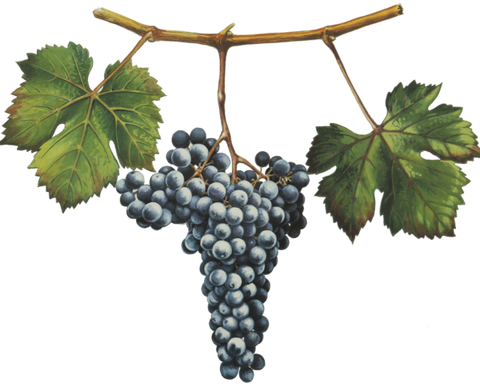DOLCETTO

Sprout: April
Flowering: June
Start of ripening/color change: August
Ripening: September
Harvest: September
Pruning system: Guyot or mixed system with one fruiting cane with 8-10 buds
Dolcetto d'Alba is a DOC wine that is traditionally Langhe's most consumed table wine. In the less prosperous times of the last century, the Dolcetto wines were drunk by the winegrower and the more expensive Nebbiolo wines were sold.
Dolcetto d'Alba is one of the most typical and widespread vines in Piedmont and probably owes its name to the sweetness of its ripe grapes, or, according to another theory, to the word "dosset", which in the Piedmontese dialect refers to a low hill. Dolcetto thrives on low or slightly less sunny parts of the hill. That is also the reason why there are still relatively many Dolcetto vines planted, it can coexist perfectly with Nebbiolo. That does not mean that it is an easy grape to grow. The moment of harvest in particular is of vital importance for the Dolcetto. It can make the difference between a fantastic or mediocre wine.
The wine made from Dolcetto grapes has been one of the protagonists of rural life in Piedmont for centuries and was used as a medium of exchange for obtaining oil, salt and anchovies from the Liguria region. Nevertheless, information about Dolcetto can only be found from the eighteenth century onwards. The Dolcetto d'Alba wine received the DOC label in 1974.
The production area of Dolcetto d'Alba DOC wine includes the entire territory of the municipalities of Alba, Albaretto della Torre, Arguello, Barolo, Benevello, Borgomale, Bosia, Camo, Castiglione Falletto, Castiglione Tinella, Castino, Cossano Belbo, Grinzane Cavour Lequio Berria , Mango, Monforte d'Alba, Montelupo Albese, Neviglie, Rocchetta Belbo Rodello, S. Stefano Belbo, Serralunga d'Alba, Sinio, Treiso, Trezzo Tinella in the province of Cuneo, the municipality of Coazzolo in the province of Asti, and part of the municipal territory of Barbaresco, Cherasco, Narzole, Neive, Novello, La Morra, Roddi, Verduno, Roddino, Torre Bormida and Cortemilia.
Color: ruby red, tending to purple
Perfume: wine cellar, earthy, pleasant, dark fruit, bitter
Taste: dry, full fruity and pleasantly bitter, with moderate acidity, good body and harmonious.
Very tasty with anti-pasta and with various types of risotto and ravioli, veal and beef.